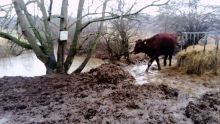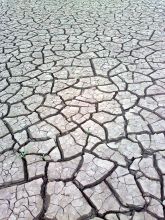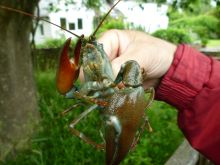Water Quality

Poor water quality can be caused by many different factors. In urban areas, road runoff contains contaminants from vehicles - for example, heavy metals and oil- or petrol-related pollutants that have been shown to be harmful to aquatic communities. Other sources of pollution are industrial waste or overloaded sewage treatment works. In rural areas, many homes and small businesses are serviced by septic tanks or small package treatment works, which have been shown to contribute to the high levels of nutrients (particularly phosphates) in rivers. High nutrients lead to excessive growth of vegetation which can restrict the channel and, in some cases, result in the development of algal blooms. The effectiveness of septic tanks and package treatment works can also be reduced by some household products.
Everyday agricultural activities can have a huge impact on the amount of nutrients, pesticides and sediment which reach watercourses. For example, poor soil management can result in excessive inputs of fine sediments, smothering the riverbed and contributing to localised flooding. Extreme rainfull can overwhelm slurry stores on dairy farms, leading to high levels of organic matter and ammonia entering the rivers. Excessive or inappropriate use of fertilisers and pesticides also compromises water quality.
All these factors can seriously damage aquatic plants and animals, and lead to a reduction in their variety and the part they play in creating a balanced ecosystem. For water companies, water quality issues may also increase the costs of safeguarding the quality of the water which they supply to homes and businesses.
The Medway Catchment Partnership works closely with farmers and landowners to help develop strategies that reduce these impacts on rivers. In many cases, small changes have big effects, and many also help improve farm productivity and viability.
Water Quantity

Flooding - The increase in impervious surfaces like roads, roofs and pavements in towns, and the compaction of soils from heavy farm machinery or overstocking (especially in the clay based soils of much of the Medway catchment) reduce the amount of water that can escape through the land surface. Poor infiltration of water to the subsurface soils results in increased overland flow and an increase in flood risk. Over-development of land in the floodplain reduces the available space for temporary water storage during high rainfall, leading to more damage to homes, businesses and infrastructure.
Drought - Over-abstraction for agriculture and horticulture, and to supply more and more water for growing numbers of people and businesses, leads to water shortages in dry summers. On the other hand, factors like impervious surfaces, compacted soils, and streams and rivers which have been dredged and straightened in order to get rainfall out to the Thames as fast as possible, also reduce the amount of water that is available to be stored in the catchment.
Habitat

Incised Channels - The river channels of the Upper Medway and River Eden are heavily incised. Incision is when a river has cut or eroded downward through its riverbed, leaving deep, steep sided banks. This usually occurs as the river's response to historical river modification, including in-river structures (like weirs, dams and mills) and dredging. The Medway valley contains many pill-boxes and was an important defensive line in WW2. Some of the dredged channels may have been designed to make the river channel an anti-tank defence.
An incised channel poses two main problems:
- Aquatic ecology: An incised channel is only able to connect to its floodplain in extreme flood events, which means that higher than normal water velocity is maintained in the channel during small to medium flood events. Aquatic wildlife (such as juvenile fish) may be swept downstream during these spates. Due to the steep banks there is also a lack of marginal transitional habitats, which is are important habitats in their own right, and also provide a refuge for wildlife in flood conditions.
- Flooding downstream: Flood risk may be increased downstream. Because the incised channel only connects with its floodplain during extreme flood events, the floodplain cannot store water in this location during small to medium flood events. This water that cannot be stored in the floodplain in this location, as it naturally would, flows quickly downstream to areas where it may contribute to or exacerbate flooding.
Dredging and Straightening - These physical modifications cause reduced variation, both in habitat and hydrology, and have similar impacts as an incised channel. Dredging and straightening results in a lack of refuge areas for small fish to shelter from predators, or for larger fish to hide in during high flows. The reduction in marginal habitat (gently sloping banks and emergent vegetation) limits biodiversity by removing suitable areas for mammals such as water voles and insects such as dragonflies, and leads to reduced feeding for birds and small mammals.
When dredging is carried out, raised banks are formed from dredged material, which also disconnect the river from its floodplain. If a flood tops these banks, it can strand fish and invertebrates and increase the time the floodplain is inundated as the water cannot easily flow back into the river. Steep sided banks are less likely to vegetate, and are more prone to erosion.
Weirs and barriers to fish migration - Weirs and other in-stream barriers have been installed in rivers for a variety of reasons but they all have similar effects. Slowing the flow of water upstream results in a reduction in dissolved oxygen levels, and slower flows mean that fine sediments drop out of the water column, smothering the river bed. As fish often spawn on the river bed or in vegetation attached to the river bed, the fine sediment damages fish spawning habitats by blocking oxygen from reaching developing eggs.
Natural processes that encourage the formation of instream habitats, like riffles and pools, are inhibited, resulting in a uniform channel that is more like a canal or lake habitat than a river. These impounding effects can exist for several hundreds of meters upstream of each weir structure and with over 200 weirs in the Medway catchment, a significant proportion of natural habitat in the river can be lost. The migration of fish and other animals is blocked, leaving isolated populations that are more vulnerable to extreme events such as droughts or pollution. In conjunction with high flows and a lack of refuge areas, this may result in whole populations disappearing from a reach as they get washed downstream and cannot get back past the weir. For more information on the impacts of weirs, see here: http://www.southeastriverstrust.org/how-weirs-affect-fish-communities/
Invasive Non-Native Species

INNS such as Himalyan balsam and signal crayfish can have serious effects on a catchment's native plants, animals and fish by out-competing them - often due to the lack of natural predators, or by introducing diseases to which the native communities have not developed immunity. Invasive non-native species can also have other detrimental effects. For instance, Himalayan balsam out-competes native vegetation by shading out the available light during the summer. In the winter, it dies back, leaving bare soils that are vulnerable to erosion. This increases the amount of silt that may be washed into the river, and reduces the available bankside habitat for small mammals and insects during the winter.